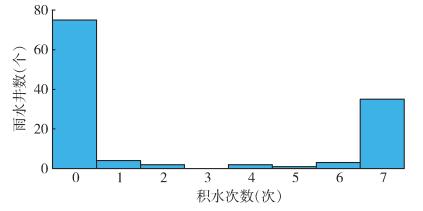扩展功能
文章信息
- 任志华, 刘天, 陈家昕, 王玉峰, 陈紫旖, 周毅彬
- REN Zhi-hua, LIU Tian, CHEN Jia-xin, WANG Yu-feng, CHEN Zi-yi, ZHOU Yi-bin
- 5%吡丙醚·倍硫磷颗粒剂对居民小区雨水井幼蚊控制效果研究
- A study of effectiveness of 5% pyriproxyfen and fenthion granules in controlling mosquito larvae in rainwater wells in residential areas
- 中国媒介生物学及控制杂志, 2021, 32(3): 374-377
- Chin J Vector Biol & Control, 2021, 32(3): 374-377
- 10.11853/j.issn.1003.8280.2021.03.023
-
文章历史
- 收稿日期: 2020-08-11
2 上海市疾病预防控制中心传染病防治所, 上海 200336
2 Institute for Prevention and Control of Infectious Diseases, Shanghai Municipal Center for Disease Control and Prevention, Shanghai 200336, China
蚊虫能传播登革热、疟疾和流行性乙型脑炎(乙脑)等多种人类传染病[1],其中,登革热在我国具有典型的输入性和突发性[2]。登革热近年来在我国多地暴发,其治疗及预防缺乏特效药物及有效疫苗[3-4],因此监测和控制媒介伊蚊的密度显得尤为重要。
2017年7月,上海市虹口、黄浦及松江区疾病预防控制中心联合开展了上海市地面排水系统的蚊虫状况调查,结果显示居民小区雨水井蚊虫孳生阳性率最高[5],同时根据病媒生物日常监测及调查发现,上海市城区白纹伊蚊(Aedes albopictus)在7—8月达密度高峰[6]。为掌握白纹伊蚊高峰期居民小区雨水井积水情况、蚊虫孳生情况及5%吡丙醚·倍硫磷颗粒剂对幼蚊的控制效果,我们于2019年8—9月对1处居民区雨水井开展了积水情况观察和药物控制效果研究。
1 材料与方法 1.1 研究区域在上海市青浦区选择1个雨水井类型较为统一的小区,小区占地面积约56 938 m2,总建筑面积约70 578 m2。本次共调查路旁竖篦雨水井122个,雨水井主要分为2种:55 cm×40 cm(115个)及55 cm×55 cm(7个)。小区中央有1条河流(宽度约40 m)穿过,将小区分为南、北两部分,南部64个雨水井作为实验组,北部58个雨水井作为对照组。
1.2 雨水井调查方法参照上海市地方标准DB31/330.2-2006《鼠害与虫害预防与控制技术规范第2部分:蚊虫防制》,结合目测法与水勺法进行调查,调查人员用手电筒,对小区地面环境雨水井进行检查,发现有Ⅱ龄及以上的幼蚊或蛹的水体作为阳性孳生地,对发现阳性的雨水井用500 ml水勺捞取积水,每处捞取2勺,记录幼蚊数及蛹数,以平均数代表该阳性孳生地幼蚊密度(条/勺)。
1.3 雨水井积水、幼蚊控制及效果观察调查小区全部雨水井积水情况,积水面积不足1/4按1/4记录,1/4~1/2按1/2记录,1/2~1按全积水记录。对照组不投放任何药物,实验组积水雨水井首次使用5%吡丙醚·倍硫磷颗粒剂,按沪爱卫办〔2018〕10号《上海市病媒生物应急处置预案(2018年版)》中推荐剂量20 g/m2投放。
在白纹伊蚊密度处于高峰的8月6日至9月3日,分别于投药前,投药后1、3、7、14、21和28 d,采用500 ml水勺调查雨水井,采集2次,记录每次各阳性雨水井幼蚊密度情况;同时记录温度、湿度、降水量等。
1.4 药物及工具选择研究药物为5%吡丙醚·倍硫磷颗粒剂,由江苏功成生物科技有限公司生产。调查工具包括雨水井铁钩、强光手电筒、500 ml幼蚊调查水勺等。
1.5 统计学分析利用Excel 2010软件记录整理现场试验数据,采用SPSS 17.0软件进行统计学分析,计数资料采用率和百分比,阳性率间的比较采用χ2检验,P < 0.05为差异有统计学意义。
2 结果 2.1 实验期间气象因素研究区域2019年8—9月气象因素从上海市青浦区气象局获取,包括日平均气温、日平均湿度及日降水量,实验期间为高温季节,降水也较频繁,调查前3 d相关气象因素见表 1。

|
2019年8月6日至9月3日,分别对试验区域122个雨水井开展了7次积水调查,共调查雨水井854个,发现有积水284个,雨水井平均积水率为33.26%,试验区域总雨水井积水率在30.33%~36.89%,积水率差异无统计学意义(χ2=1.176,P=0.278),积水率与调查前3 d总降水量无相关性(r=0.558,P=0.193),实验组与对照组积水率差异无统计学意义(χ2=2.567,P=0.110),居民小区雨水井具体积水情况见表 2。

|
该居民小区122个雨水井在7次调查中,均未积水的有75个(占61.48%),积水1~6和7次的分别有12和35个,分别占9.83%和28.69%。见图 1。

|
| 图 1 2019年8—9月上海市青浦区居民区雨水井调查积水次数情况 Figure 1 Number of investigated water accumulations in the rainwater wells in the residential area of Qingpu district of Shanghai from August to September, 2019 |
| |
2019年8月6日,共调查小区雨水井122个,发现有积水的43个,蚊虫孳生的25个,蚊虫孳生阳性率为58.14%。实验组雨水井在调查后立即开展了5%吡丙醚·倍硫磷颗粒剂投放控制工作,投放标准为20 g/m2。在投放药物后第1天,实验组雨水井幼蚊孳生阳性率由62.50%下降至16.67%,差异有统计学意义(χ2=4.689,P=0.027),投药后第3天雨水井未发现孳生阳性情况,药效持续14 d;21 d后蚊虫孳生阳性率为23.81%,28 d后为38.46%,与对照组比较差别均无统计学意义(均P > 0.05)。
8月6日至9月3日,对照组幼蚊孳生阳性率在41.18%~55.56%,幼蚊孳生阳性率无明显变化(χ2=0.252,P=0.769)。居民小区雨水井调查的积水率及幼蚊孳生情况见表 3。

|
近年来,蚊虫及蚊媒传染病在全球范围均出现迅速蔓延趋势[7],蚊媒传染病的迅速蔓延导致了严重的公共卫生问题。白纹伊蚊为半野栖型蚊种,其幼蚊孳生处理对象主要包括废旧轮胎、闲置容器(碗、瓶、缸、罐)、竹筒、树洞、石穴、贮水池、缸、盆等[8]。随着城市化的快速发展,2017年王飞等[5]调查表明雨水井是城市白纹伊蚊重要的孳生场所,其中居民小区雨水井蚊虫孳生更为明显。
本研究发现,在8—9月高温季节雨水井积水率维持在30.33%~36.89%,与平均气温及前3 d降水量无相关性。蚊虫高峰期间7次调查中发现,该小区雨水井积水情况基本稳定,提示该居民小区雨水井积水与气候因素相关性较低,而幼蚊控制工作可重点对长期保持积水点位开展,同时可降低居民小区雨水井幼蚊控制总用药量和控制成本。
本次研究选择的雨水井全部为篦子型。本次调查发现小区雨水井幼蚊孳生阳性率为58.14%,该小区雨水井幼蚊孳生阳性率处于较高水平,需要重点关注及开展控制工作。目前幼蚊孳生地控制,常用的药物有双硫磷[9]、倍硫磷、苏云金杆菌及球形芽孢杆菌等,2015—2016年刘洪霞等[10]对上海市多区开展了白纹伊蚊幼蚊抗药性调查,发现上海市多个区对双硫磷产生了中低抗性。2016年起上海市爱国卫生运动委员会办公室组织全市使用双硫磷砂粒剂开展了多轮雨水井幼蚊控制工作,这也可能促进了幼蚊对双硫磷抗药性的产生及增强。本次现场试验发现,在自然条件下,5%吡丙醚∙倍硫磷颗粒剂对雨水井幼蚊的控制持续时间可达2周,第3周幼蚊水平已基本恢复到投药前,提示我们在使用该药物时要掌握好投药间隔,以科学控制雨水井幼蚊孳生。同时,在连续使用药物的同时,我们应做好抗药性监测工作,针对抗药性结果调整药物的使用量,以做到科学防控幼蚊。
本次调查小区为2006年建成,8—9月雨水井积水率与幼蚊孳生率稳定。经调查及询问发现,该小区雨水井内积泥长期未开展清理,对雨水井的积水情况有一定的影响。其他新小区及老旧小区雨水井积水情况是否与之相同,需选择一定数量不同类型小区开展进一步调查研究工作。
利益冲突 无
| [1] |
Achee NL, Grieco JP, Vatandoost H, et al. Alternative strategies for mosquito-borne arbovirus control[J]. PLoS Negl Trop Dis, 2019, 13(1): e0006822. DOI:10.1371/journal.pntd.0006822 |
| [2] |
孟凤霞, 王义冠, 冯磊, 等. 我国登革热疫情防控与媒介伊蚊的综合治理[J]. 中国媒介生物学及控制杂志, 2015, 26(1): 4-10. Meng FX, Wang YG, Feng L, et al. Review on dengue prevention and control and integrated mosquito management in China[J]. Chin J Vector Biol Control, 2015, 26(1): 4-10. DOI:10.11853/j.issn.1003.4692.2015.01.002 |
| [3] |
张亚萍, 刘增加, 韩雪玲, 等. 登革热和登革出血热的临床治疗进展[J]. 医学动物防制, 2015, 31(4): 393-395. Zhang YP, Liu ZJ, Han XL, et al. The clinical research progress of dengue fever and dengue hemorrhagic fever[J]. J Med Pest Control, 2015, 31(4): 393-395. DOI:10.7629/yxdwfz201504013 |
| [4] |
毛祥华, 张再兴. 中国登革热的流行现状[J]. 中国病原生物学杂志, 2007, 2(5): 385-388. Mao XH, Zhang ZX. Current situation of the dengue fever in China[J]. J Pathog Biol, 2007, 2(5): 385-388. DOI:10.13350/j.cjpb.2007.05.024 |
| [5] |
王飞, 高强, 吕锡宏, 等. 上海市地面排水系统2017年蚊虫孳生状况调查研究[J]. 中国媒介生物学及控制杂志, 2018, 29(3): 259-262. Wang F, Gao Q, Lyu XH, et al. Breeding status of mosquitoes in municipal drainage system of Shanghai, China in 2017[J]. Chin J Vector Biol Control, 2018, 29(3): 259-262. DOI:10.11853/j.issn.1003.8280.2018.03.010 |
| [6] |
曹晖, 冷培恩, 周毅彬, 等. 黑箱法和CO2诱捕法在成蚊监测中的比较研究[J]. 中华卫生杀虫药械, 2009, 15(6): 445-448. Cao H, Leng PE, Zhou YB, et al. The comparison study of red box and CO2 trap in mosquito surveillence[J]. Chin J Hyg Insect Equip, 2009, 15(6): 445-448. DOI:10.19821/j.1671-2781.2009.06.006 |
| [7] |
Tolle MA. Mosquito-borne diseases[J]. Curr Probl Pediatr Adolesc Health Care, 2009, 39(4): 97-140. DOI:10.1016/j.cppeds.2009.01.001 |
| [8] |
曹一鸥, 周兴余, 刘学成, 等. 四川省2016-2018年登革热媒介伊蚊监测结果分析[J]. 中国媒介生物学及控制杂志, 2020, 31(2): 185-189. Cao YO, Zhou XY, Liu XC, et al. An analysis of surveillance results of dengue vector Aedes in Sichuan province, China, 2016-2018[J]. Chin J Vector Biol Control, 2020, 31(2): 185-189. DOI:10.11853/j.issn.1003.8280.2020.02.013 |
| [9] |
莫旦红, 朱敏慧, 刘丽军, 等. 1%双硫磷颗粒剂对上海市居民区雨水井内蚊虫控制效果研究[J]. 中国媒介生物学及控制杂志, 2018, 29(4): 391-393. Mo DH, Zhu MH, Liu LJ, et al. Study on the control effect of 1%temephos granules on the mosquitoes in the rainwater wells in residential areas of Shanghai[J]. Chin J Vector Biol Control, 2018, 29(4): 391-393. DOI:10.11853/j.issn.1003.8280.2018.04.018 |
| [10] |
刘洪霞, 朱江, 刘曜, 等. 上海地区2015-2016年白纹伊蚊幼虫监测及抗药性调查[J]. 中国媒介生物学及控制杂志, 2017, 28(4): 305-307, 331. Liu HX, Zhu J, Liu Y, et al. Study on the seasonal dynamics and insecticides resistance of Aedes albopictus larvae, in Shanghai, 2015-2016[J]. Chin J Vector Biol Control, 2017, 28(4): 305-307, 331. DOI:10.11853/j.issn.1003.8280.2017.04.001 |
 2021, Vol. 32
2021, Vol. 32


